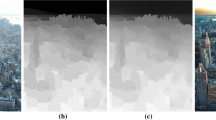Abstract
The common dehazing algorithms always assume that the transmission values of all the pixels in an image block are the same (local consistency assumption). However, it is easy to appear “halo” for image regions where the depth changes obviously. In this paper, we calculate the transmission of each pixel separately without the local consistency assumption. First, we initialize a random transmission value for each pixel in the whole image. Then, we optimize the transmission values through several iterations by minimizing an energy function, which contains the data term and penalty term. In each iteration, we take two procedures of propagation and random search to optimize transmission values. Finally, we use the optimized transmission and the estimated atmospheric light to calculate the haze-free image. Comparison experiments show that our algorithm can remove haze effectively, and obtain the best performance.













Similar content being viewed by others
References
Berman D, Treibitz T, Avidan TS (2016) Non-local image dehazing. Proc IEEE Conf Comput Vis Pattern Recognit, pp 1674–1682
Bui TM, Kim W (2018) Single image dehazing using color ellipsoid prior. IEEE Trans Image Process 27(2):999–1009
Carnec M, Le Callet P, Barba D (2008) Objective quality assessment of colour images based on a generic perceptual reduced reference. Signal Process Image Commun 23(4):239–256
Economopoulos TL, Asvestas PA, Matsopoulos GK (2010) Contrast enhancement of images using partitioned iterated function systems. Image Vis Comput 28(1):45–54
Engin D, Genc A, Ekenel HK (2018) Cycle-dehaze: enhanced cyclegan for single image dehazing. Proc IEEE Conf Comput Vis Pattern Recognit Work, In, pp 825–833
Fattal R (2008) Single image dehazing. ACM Trans Graph 27(3):1–10
Gao Y, Chen H, Li H, Zhang W (2018) Single image dehazing using local linear fusion. IET Image Process 12(5):637–643
Hautire N, Tarel JP, Aubert D et al (2008) Blind contrast enhancement assessment by gradient ratioing at visible edges. Image Anal and Stereology J 27(2):87–95
He K, Sun J, Tang X (2011) Single image haze removal using dark channel prior. IEEE Trans Pattern Anal Mach Intell 33(12):2341–2353
Huang D, Chen K, Lu J et al (2017) Single image dehazing based on deep neural network. 2017 Int Conf Comput Network Electron Autom, pp 294–299
Kim JH, Jang WD, Sim JY, Kim CS (2013) Optimized contrast enhancement for real time image and video dehazing. J Vis commun Image Represent 24(3):410–425
Koschmeider H (1924) Therie der horizontalen sichtweite. Beitr Phys Freien Atm 12:171–178
Kratz L, Nishino K (2009) Factorizing scene albedo and depth from a single foggy image. Proceedings of the 12th IEEE International Conference on Computer Vision. IEEE, Kyoto, pp 1701–1708
Li Z, Zheng J (2015) Edge-preserving decomposition-based single image haze removal. IEEE Trans Image Process 24(12):5432–5441
Li Y, Miao Q, Song J et al (2015) Single image haze removal based on haze physical characteristics and adaptive sky region detection. Neurocomputing 182:221–234
Meng G, Wang Y, Duan J et al (2013) Efficient image dehazing with boundary constraint and contextual regularization. Proc IEEE Int Conf Comput Vis:617–624
Mi Z, Zhou H, Zheng Y et al (2016) Single image dehazing via multi-scale gradient domain contrast enhancement. IET Image Process 10(3):206–214
Narasimhan SG, Nayar SK (2003) Interactive (de) weathering of an image using physical models. Proc IEEE Workshop Colour Photometric Methods Comput Vis 6(6.4):1–8
Rahman Z, Woodell GA, Jobson DJ (1997) Acomparison of the multiscale retinex with other image enhancement techniques. Proc IST 50th Anniversary Conf:1–6
Ren W, Liu S, Zhang H et al (2016) Single image dehazing via multi-scale convolutional neural networks. Eur Conf Comput Vis, In, pp 154–169
Sheikh HR, Bovik AC, Cormack L (2005) No reference quality assessment using natural scene statistics: JPEG2000. IEEE Trans Image Process 14(11):1918–1927
Shwartz S, Namer E, Schechner YY (2006) Blind haze separation, vol 2. Proc. IEEE Comput Soc Conf Comput Vis Pattern Recognit, pp 1984–1991
Song Y, Li J, Wang X et al (2018) Single image dehazing using ranking convolutional neural network. IEEE Trans Multimed 20(6):1548–1560
Tan RT (2008) Visibility in bad weather from a single image. Proc IEEE Conf Comput Vision Pattern Recognit:1–8
Tang K, Yang J, Wang J (2014) Investigating haze-relevant features in a learning framework for image dehazing. Proc IEEE Conf Comput Vis Pattern Recognit, In, pp 2995–3000
Tarel JP, Hautiere N (2009) Fast visibility restoration from a single color or gray level image. IEEE Int Conf Comput Vis, pp:2201–2208
Tripathi AK, Mukhopadhyay S (2012) Removal of fog from images. IETE Tech Review 29(2):148–156
Wang Z, Bovik AC, Sheikh HR, Simoncelli EP (2004) Image quality assessment: from error visibility to structural similarity. IEEE Trans Image Process 13(4):600–612
Wang J, He N, Zhang L, Lu K (2015) Single image dehazing with a physical model and dark channel prior. Neurocomputing 149:718–728
Wang A, Wang W, Liu J, Gu N (2019) AIPNet: image-to-image single image dehazing with atmospheric illumination prior. IEEE Trans Image Process 28(1):381–393
Zhang H, Patel VM (2018) Densely connected pyramid dehazing network. Proc. IEEE Conf Comput Vis Pattern Recognit, pp 3194–3203
Zhang H, Sindagi V, Patel VM (2018) Multi-scale single image dehazing using perceptual pyramid deep network. IEEE Conf Comput Vis Pattern Recognit Work, In, pp 902–911
Acknowledgements
Thanks to Dr. Cunjun Xiao for his help in revising this paper.
Author information
Authors and Affiliations
Corresponding author
Ethics declarations
Conflict of interest
The authors declare that they have no conflict of interest.
Additional information
Publisher’s note
Springer Nature remains neutral with regard to jurisdictional claims in published maps and institutional affiliations.
Rights and permissions
About this article
Cite this article
Gao, Y., Zhang, Y., Li, H. et al. Single image dehazing based on single pixel energy minimization. Multimed Tools Appl 80, 5111–5129 (2021). https://doi.org/10.1007/s11042-020-08964-w
Received:
Revised:
Accepted:
Published:
Issue Date:
DOI: https://doi.org/10.1007/s11042-020-08964-w




